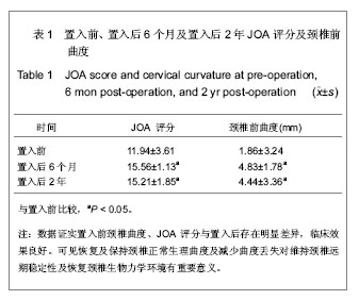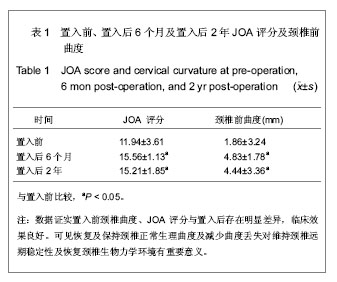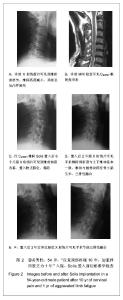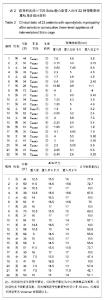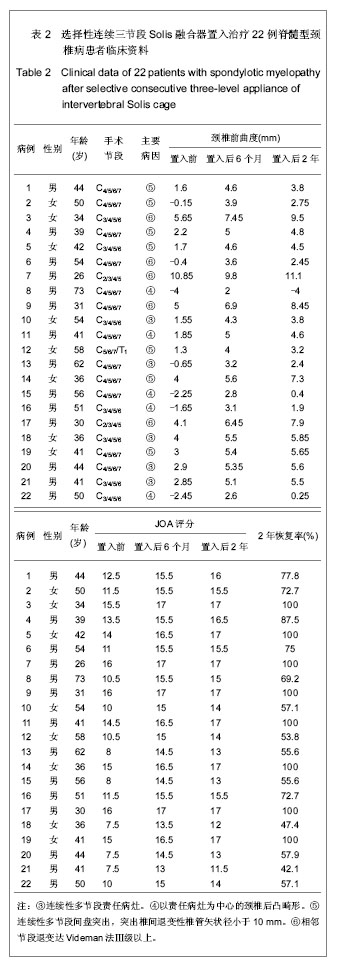| [1] Katsuura A, Hukuda S, Saruhashi Y,et al. Kyphotic malalignment after anterior cervical fusion is one of the factors promoting the degenerative process in adjacent intervertebral levels. Eur Spine J. 2001;10(4):320-324.
[2] Kawakami M, Tamaki T, Yoshida M,et al. Axial symptoms and cervical alignments after cervical anterior spinal fusion for patients with cervical myelopathy. J Spinal Disord. 1999; 12(1):50-56.
[3] Helgeson MD, Bevevino AJ, Hilibrand AS. Update on the evidence for adjacent segment degeneration and disease. Spine J. 2013;13(3):342-351.
[4] Toledano M, Bartleson JD. Cervical spondylotic myelopathy. Neurol Clin. 2013;31(1):287-305.
[5] Muthukumar N. Surgical management of cervical spondylotic myelopathy. Neurol India. 2012;60(2):201-209.
[6] Hatta Y, Shiraishi T, Hase H,et al. Is posterior spinal cord shifting by extensive posterior decompression clinically significant for multisegmental cervical spondylotic myelopathy. Spine (Phila Pa 1976). 2005;30(21):2414-2419.
[7] Cho DY, Liau WR, Lee WY,et al. Preliminary experience using a polyetheretherketone (PEEK) cage in the treatment of cervical disc disease. Neurosurgery. 2002;51(6):1343-1349.
[8] Mastronardi L, Ducati A, Ferrante L. Anterior cervical fusion with polyetheretherketone (PEEK) cages in the treatment of degenerative disc disease. Preliminary observations in 36 consecutive cases with a minimum 12-month follow-up. Acta Neurochir (Wien). 2006;148(3):307-312.
[9] Wang SJ, Jiang SD, Jiang LS,et al. Axial pain after posterior cervical spine surgery: a systematic review. Eur Spine J. 2011; 20(2):185-194.
[10] Kawaguchi Y, Kanamori M, Ishiara H,et al. Preventive measures for axial symptoms following cervical laminoplasty. J Spinal Disord Tech. 2003;16(6):497-501.
[11] Wang YJ, Shi Q, Lu WW,et al. Cervical intervertebral disc degeneration induced by unbalanced dynamic and static forces: a novel in vivo rat model. Spine (Phila Pa 1976). 2006;31(14):1532-1538.
[12] Wang JC, McDonough PW, Endow KK,et al. Increased fusion rates with cervical plating for two-level anterior cervical discectomy and fusion.Spine (Phila Pa 1976). 2000;25(1): 41-45.
[13] Matgé G. Cervical cage fusion with 5 different implants: 250 cases. Acta Neurochir (Wien). 2002;144(6):539-549.
[14] Mastronardi L, Ducati A, Ferrante L. Anterior cervical fusion with polyetheretherketone (PEEK) cages in the treatment of degenerative disc disease. Preliminary observations in 36 consecutive cases with a minimum 12-month follow-up. Acta Neurochir (Wien). 2006;148(3):307-12.
[15] Vavruch L, Hedlund R, Javid D,et al. A prospective randomized comparison between the cloward procedure and a carbon fiber cage in the cervical spine: a clinical and radiologic study. Spine (Phila Pa 1976). 2002;27(16): 1694-1701.
[16] 陈德玉,贾连顺,袁文,等.颈椎前路带锁钢板临床应用的并发症及预防[J].中华骨科杂志, 2001,21(5):287-289.
[17] Yang L, Gu Y, Liang L,et al. Stand-alone anchored spacer versus anterior plate for multilevel anterior cervical diskectomy and fusion.Orthopedics. 2012;35(10): e1503- 1510.
[18] Hwang SL, Lin CL, Lieu AS,et al. Three-level and four-level anterior cervical discectomies and titanium cage-augmented fusion with and without plate fixation. J Neurosurg Spine. 2004;1(2):160-167.
[19] Helgeson MD, Bevevino AJ, Hilibrand AS. Update on the evidence for adjacent segment degeneration and disease. Spine J. 2013;13(3):342-351.
[20] Nunley PD, Jawahar A, Cavanaugh DA,et al. Symptomatic adjacent segment disease after cervical total disc replacement: re-examining the clinical and radiological evidence with established criteria. Spine J. 2013;13(1):5-12.
[21] Cho SK, Riew KD. Adjacent segment disease following cervical spine surgery. J Am Acad Orthop Surg. 2013;21(1): 3-11.
[22] Sears WR, Duggal N, Sekhon LH,et al. Segmental malalignment with the Bryan cervical disc prosthesis--contributing factors. J Spinal Disord Tech. 2007;20(2):111-117.
[23] Salari B, McAfee PC. Cervical total disk replacement: complications and avoidance. Orthop Clin North Am. 2012; 43(1):97-107.
[24] Richards O, Choi D, Timothy J. Cervical arthroplasty: the beginning, the middle, the end. Br J Neurosurg. 2012;26(1): 2-6.
[25] 潘胜发,孙宇,朱振军,等.单开门颈椎管扩大椎板成形术后轴性症状与颈椎稳定性的相关观察[J].中国脊柱脊髓杂志,2003,13(10): 604-607.
[26] Machino M, Yukawa Y, Hida T,et al. Cervical alignment and range of motion after laminoplasty: radiographical data from more than 500 cases with cervical spondylotic myelopathy and a review of the literature. Spine (Phila Pa 1976). 2012; 37(20):E1243-1250.
[27] Cho SK, Riew KD. Adjacent segment disease following cervical spine surgery. J Am Acad Orthop Surg. 2013;21(1): 3-11.
[28] Epstein N. Posterior approaches in the management of cervical spondylosis and ossification of the posterior longitudinal ligament. Surg Neurol. 2002;58(3-4):194-207.
[29] Seichi A, Takeshita K, Ohishi I,et al. Long-term results of double-door laminoplasty for cervical stenotic myelopathy. Spine (Phila Pa 1976). 2001;26(5):479-487. |
